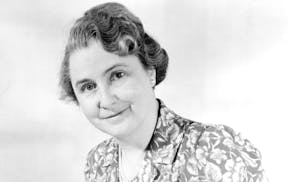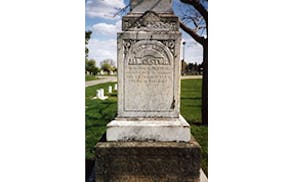The answer to my first question set the tone during a recent visit with Doris and Donald Swanson in their apartment at the New Perspective Senior Living center in Prior Lake.
"How did you two meet?" I asked the couple, both 98 and married for 75 years.
"Picked her up out of the gutter," Don deadpanned, as Dorie rolled her eyes.
Dorie Jerome was working as a clerk when they met in Minneapolis in 1946, two years after Don had escaped from a Nazi prisoner train during World War II. They were both 22.
"At that age, I wasn't very impressed — he was cocky," she said. "You had to be cocky to get away from the Germans," he said.
I've been writing Minnesota History columns for eight years, mostly about people from long ago. So, an afternoon of living history was something to relish.
We talked about the Depression, his war captivity and her experiences growing up in northwestern Minnesota with Swedish and Native blood.
"I'm a pretty lucky guy to bail out of a B-24, get away from the Germans and marry her," Don said.
To which Dorie retorted: "That's not what he usually tells me. It's more like, 'Get to work!'''
Dorie was born in Pembina, N.D., in January 1924, the great-granddaughter of legendary fur trader Joe Rolette, who is credited with keeping St. Paul as Minnesota's capital. After her mother, Nancy Sandberg, married Amos Jerome in 1917, Nancy wasn't allowed to come home because Amos was Métis, a descendant of French Canadians and Cree Indians from Saskatchewan.
Unlike her mother's eight younger siblings — each of whom received a cow when they got married — Dorie's mother had to wait for her cow until after her Swedish father died in a 1933 tractor accident.
"I grew up in an era that was racist," Dorie said. "We didn't dwell on it. I'd say I was part Swede and part French Canadian, and left the Indian part out."
Amos Jerome was a trapper and farmer, but Dorie remembers him as a great weaver of ghost stories who handcrafted sleds so his seven children could have some fun during the Depression. They grew up on farms straddling the Red River near Pembina and Hallock, Minn.
"We were happy as kids, and didn't know we were poor," she said. "A loaf of bread already sliced was something wonderful."
Born in Minneapolis two weeks before Dorie, Don Swanson was drafted into the Army in 1943 at 20. At 5-foot-6 and 128 pounds, he became a ball turret gunner on a B-24 bomber "because I was the smallest guy."
On a 1944 flight over Belgium, the pilot hollered: "Swanson, check the gauge and see if you can get any more gas." He opened the emergency fuel tank and found "nothin' goin'," Don recounted for a 2010 book on Scott County veterans, "Never Forgotten," by Tom Melchior.
Parachuting out at 12,000 feet, Swanson landed in a wheat field and was taken into hiding by members of the Belgian underground, dodging Nazis on bicycles for a couple weeks.
With a promised escort to a safe house in Brussels and then transportation to French Alliance forces, Swanson thought he and his waist gunner would be OK. But the Belgians they trusted turned them in to the Nazis for money, driving them "right to Gestapo headquarters," he told Melchior in 2009.
Don told me: "When I got out of the back of the truck, a German was pointing a gun at my stomach."
Taken to a German prison, he slept on straw and ate moldy, black bread and watery soup for a month. "They called it carrot soup," he said.
But Swanson escaped on Sept. 1, 1944, after his friends in the Belgian underground derailed the engine of a train moving prisoners to camps in Germany. He soon returned home.
Don married Dorie on Jan. 15, 1947, her 23rd birthday. They raised four kids in the Twin Cities suburbs, Otter Tail County and Montevideo while he worked as a mechanical engineer.
These days, Don admits, "I drink a little too much beer." Part of his stomach has been removed because of ulcers. He's grappled with flashbacks that once landed him in a veterans' hospital for two months.
"I got in my car one day, and I just started crying and didn't care where I was goin'," he said in 2009.
Today, Don and Dorie say they're relieved they dodged COVID-19, although the isolation proved trying. Dorie still makes her famous meatloaf and was thrilled when one of her grandchildren in Inver Grove Heights asked for her pickle recipe. They've endured one son's double amputation during the Vietnam War.
"It took a week before we learned that Robbie was alive," Dorie said.
All in all, Don said, "We're lucky people."
That includes this visitor to the third floor of the New Perspective center.
Curt Brown's tales about Minnesota's history appear each Sunday. Readers can send him ideas and suggestions at mnhistory@startribune.com. His latest book looks at 1918 Minnesota, when flu, war and fires converged: strib.mn/MN1918.

Minnesota History: Ad man turned Paul Bunyan into a folklore icon

Minnesota History: James Griffin used persistence to blaze a trail for St. Paul's Black police officers

Minnesota History: For Granite Falls doctor who tested thousands of kids for TB, new recognition is long overdue

Minnesota History: A New Ulm baker wearing a blanket fell to friendly fire in the U.S.-Dakota War


